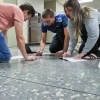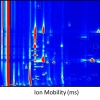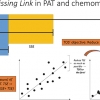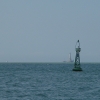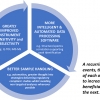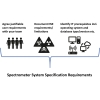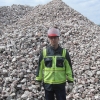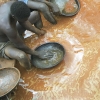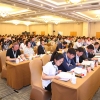The latest edition of the European Pharmacopoeia on ultraviolet and visible spectroscopy has become mandatory as of 1 January 2020, so those of you who need to comply with its requirements will find this of particular interest. Nathan and John pick apart the significant changes with a view to their practical application for instrument users. Cells, control of equipment performance, wavelength accuracy, absorbance accuracy, photometric linearity, stray light and resolution, system suitability and reference materials are all covered.
Articles and Columns
Pages
Kim Esbensen has, in his Sampling Column, been alerting us all to the dangers of ignoring sampling and explaining how to use the Theory of Sampling (TOS) to ensure correct and representative sampling. In this issue, he, with the help of Paul Bédard from the Université du Québec à Chicoutimi, shows one way in which students can be introduced to the TOS and the problems of ignoring heterogeneity in sampling. Paul Bédard has developed a simple sampling exercise based around floor tiles (see front cover) to provide his geoscience students with practical experience.
Tony and Lutgarde Buydens give us an update on the planning for the major EuroAnalysis 2021 conference, which is being held in Nijmegen, the Netherlands, at the end of August 2021. At this stage, they are keen to gather suggestions from readers on topics they would like to see covered. Groups are also invited to consider hosting their own event under the EuroAnalysis 2021 banner.
The authors offer many useful points to consider when using pre-processing techniques.
The Sampling Column points out that incorrect sampling is irreversible: no amount of chemometrics or further samples will be able to produce a valid model if the sampling is not representative. This applies in flowing PAT analyses as much as in static.
The authors have developed a clever solution to be able to provide constant resolution, high-resolution mass spectrometry data across the full spectrum. In doing so, they have assigned 244,779 unique elemental compositions: a record.
This article reports on work using NIR spectroscopy to investigate the physiology of seals during diving. As well as the versatility of NIR spectroscopy, the technical achievements involved in placing a spectrometer on a seal without harming it and recording data underwater are amazing.
Estuaries are where much of our marine pollution is to be found, being the gateway between the land and the ocean. They are also where much of our seafood comes. So, knowledge of elemental contamination in estuaries is vital to protect us from the ingestion of polluted seafood.
Rechargeable lithium ion batteries (LIBs) have a significant role in modern society: from portable electronic devices to electric cars and bicycles. Indeed, I would be surprised if anyone reading this does not have a LIB on or near them now. Both NMR and EPR spectroscopies and their imaging modalities can provide useful information, which will prove important in battery research and the development of ever improving batteries.
A recent conference on Extractables and Leachables in Hamburg not only allowed two ex-colleagues to meet after many years, but also provided information on developments and trends in the regulatory environment. Not only are ever lower levels of detection required, but also analytical requirements are being placed on companies further back in the materials’ supply chain that have not had to make such considerations before.
The Quality Matters Column highlights how the reference material industry has grown. Peter Jenks asks for your help in rerunning a 2001 survey with aim of establishing how users’ use of and experience with reference materials has changed. Whilst most questions are optional, such surveys are of the greatest value if most questions are answered. We hope you can spend a few minutes to complete the survey at https://www.spectroscopyeurope.com/reference-material-survey-2019.
This column shows how well the Theory of Sampling is able to address the powder sampling difficulties that have plagued the pharmaceutical industry for a long time. Definitely, a practical example of the importance of representative sampling.
Do you have the budget for a new instrument? Well, stop… wait! Tony Davies and Marian Draaisma have very useful guidelines. They run through questions you should be asking yourself (and your team), information you should gather and how you should go about the selection process for a new spectrometer. If you’re not buying just now, this is definitely a column you will want to bookmark for future reference.
Here starts a second round of Sampling Columns, which have been a fixture in almost every Spectroscopy Europe issue since its inauguration in 2014. The first series, which concluded in the last issue, provides a stand-alone collection for easy, free access to a first curriculum of the Theory and Practice of Sampling. The second series of Sampling Columns will focus on sampling in practice, special issues and features (left out of the first series), educational gems and other bits-and-bobs. The last two items comprise a mixture of topics and issues that also will illustrate and educate readers, but specifically only after a first minimum of TOS competence has been acquired
The authors describe work they are doing to develop a green methodology to determine soil organic matter. If the World’s population is to be fed in the future, improvements to agricultural productivity are required and soil fertility will be key to this. Current methodologies are time-consuming and expensive, but visible-near infrared spectroscopy has the potential to replace them.
Burned bones are often found in archaeological sites as a result of fire or funerary practices and are often the only preserved human remains. Using inelastic neutron scattering, infrared and micro-Raman spectroscopies, the authors can reach definitive conclusions as to the temperature at which the bone was burned. This enables archaeologists and anthropologists to learn more about how ancient civilisations used fire for funerary, burial or cooking purposes.
There are now a huge number of small-scale gold miners who scratch a living (literally) from poor-quality gold deposits. One essential step in the process to produce the end product, pure gold, uses mercury to capture the gold mixed in with rock and other minerals. The quantity of mercury released annually by small-scale gold miners alone is estimated to be 3000 tons—37 % of global mercury pollution! Whilst this causes local pollution, much of the mercury ends up being distributed around the world as droplets in “mercury flour”. This enters the water supply and hence the food chain of us and other animals. Amongst all the bad news, there is a glint of good news. Chemistry can come to the rescue and can help recover the mercury left behind by the process, and, because gold itself is a by-product, the process could be self-funding.
Tony Davies and Roy Goodacre raise some issues around the reliance just on vast quantities of data collection in omics experiments. As they put it, should we “just keep throwing the mass spectra, nuclear magnetic resonance data sets and our ion mobility fingerprints onto a big pile for the statisticians to fight over?”.
A report on the 9th World Conference on Sampling and Blending (WCSB9), held in Beijing from 7–9 May 2019.
Some compliance requirements would seem to make impossible demands on the performance specification of “fitness for purpose” for ultraviolet spectrometers; Chris and John unravel what’s going on.


